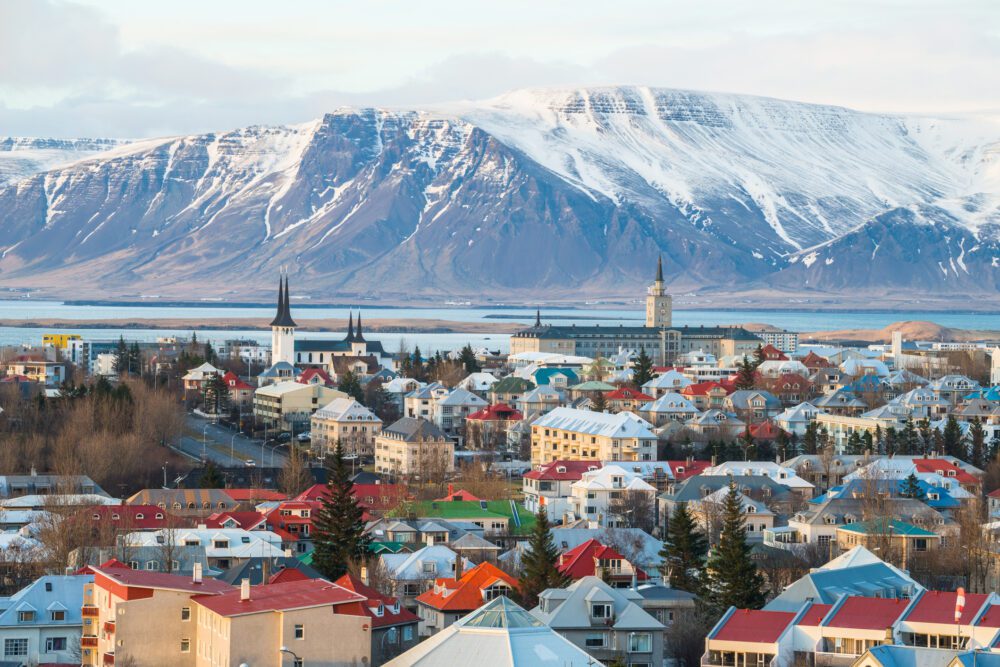
Introduction
Nestled on the rugged coastline of Iceland, Reykjavik beckons travellers with its unique blend of natural wonders, vibrant culture, and rich history. As the world’s northernmost capital, Reykjavik is a city of contrasts, where modernity meets tradition against a backdrop of stunning landscapes. Founded by Norse settlers in the 9th century, Reykjavik has evolved into a dynamic urban centre renowned for its creative energy, innovative spirit, and warm hospitality. From its colourful houses and bustling streets to its geothermal pools and awe-inspiring vistas of the surrounding mountains and sea, Reykjavik offers a wealth of experiences that captivate the imagination and leave visitors spellbound.
Reykjavik’s allure lies not only in its breathtaking natural beauty but also in its rich cultural heritage and vibrant arts scene. With a population of just over 130,000 people, Reykjavik boasts a cosmopolitan atmosphere that belies its small size, attracting artists, musicians, and creatives from around the world. Explore the city’s eclectic mix of museums, galleries, and theatres, or immerse yourself in its thriving culinary scene, where fresh seafood, traditional Icelandic delicacies, and innovative Nordic cuisine await. Whether marvelling at the otherworldly beauty of the Northern Lights, embarking on a whale-watching excursion, or simply strolling along the scenic waterfront, Reykjavik offers an unforgettable adventure that promises to leave a lasting impression on all who visit.
Table of Contents
Map of the Best Things to Do in Reykjavik
Hallgrímskirkja Church
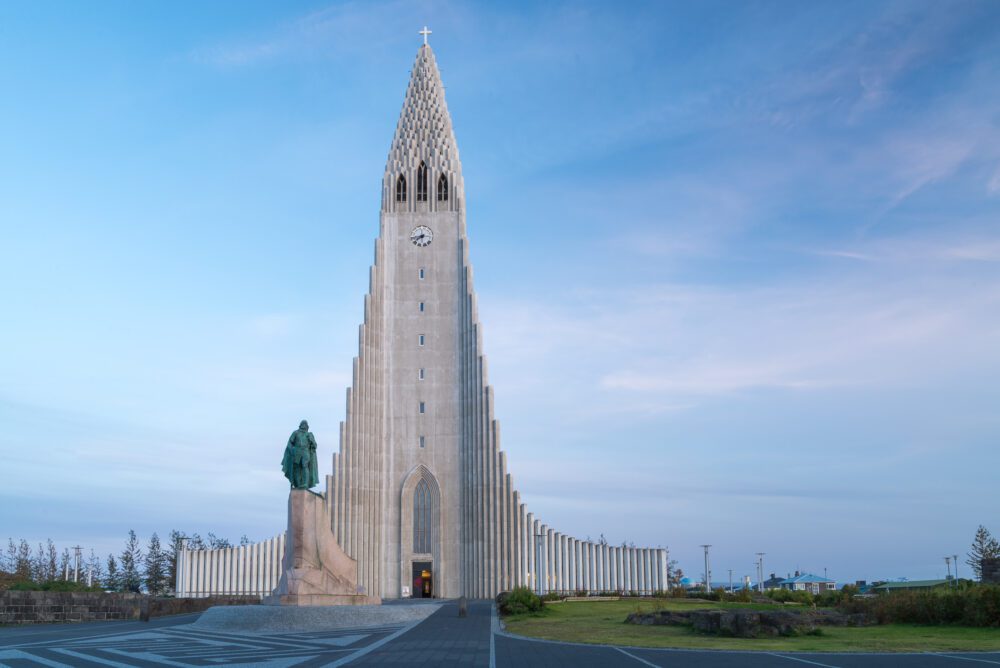
Dominating the Reykjavik skyline with its striking design, Hallgrímskirkja is Iceland’s largest church and one of the city’s most iconic landmarks. Named after the Icelandic poet and clergyman Hallgrímur Pétursson, the church took over 40 years to construct, with its construction beginning in 1945 and completed in 1986. Designed by architect Guðjón Samúelsson, the church’s towering concrete facade is inspired by the rugged landscapes of Iceland, resembling the hexagonal basalt columns found in the country’s natural formations. Visitors can ascend to the top of the church’s tower for panoramic views of Reykjavik and beyond, offering a breathtaking perspective of the city and its surroundings. Inside, the church’s interior is minimalist yet awe-inspiring, featuring a grand pipe organ and striking stained glass windows that bathe the space in colourful light. Hallgrímskirkja is not only a place of worship but also a cultural hub, hosting regular concerts and events that showcase Iceland’s rich musical heritage.
For those planning to visit Hallgrímskirkja, it’s advisable to arrive early in the day to avoid crowds and enjoy a quieter experience. The church is open to visitors throughout the week, with guided tours available for those interested in learning more about its history and architecture. Additionally, visitors can attend one of the church’s regular organ concerts, which showcase the impressive sound of its 25-ton pipe organ. After exploring the church, be sure to wander around the nearby neighbourhood of Skólavörðuholt, where charming streets lined with colourful houses, cosy cafes, and boutique shops await. Hallgrímskirkja stands as a symbol of Reykjavik’s enduring spirit and is a must-visit destination for anyone exploring Iceland’s vibrant capital city.
Sun Voyager
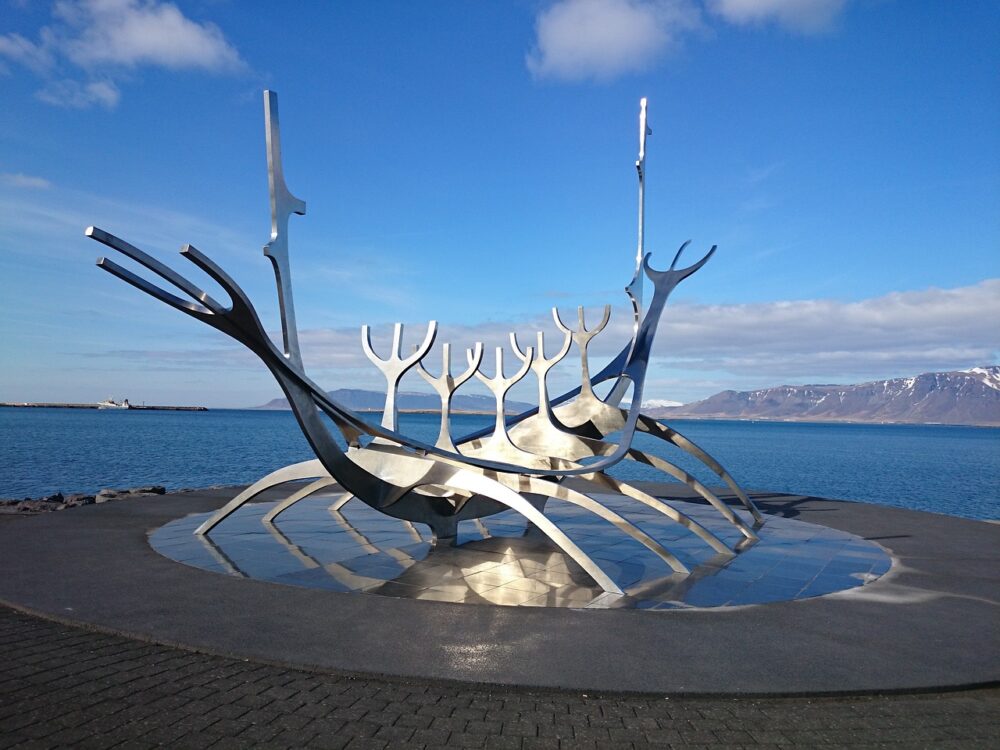
Sculpted by Jón Gunnar Árnason and unveiled in 1990 to commemorate Reykjavik’s 200th anniversary, the Sun Voyager, or Sólfar in Icelandic, is a mesmerizing sculpture located along the city’s scenic waterfront. Despite its name, the sculpture is not a Viking ship as commonly believed but rather a dream boat or ode to the sun, symbolizing hope, progress, and the promise of new opportunities. Its sleek, polished steel design evokes the shape of a Viking ship, with its prow pointed towards the North Atlantic Ocean. The Sun Voyager has become one of Reykjavik’s most photographed landmarks, especially during the golden hours of sunrise and sunset when the sculpture’s reflective surface captures the warm hues of the sun. Visitors often gather around the Sun Voyager to admire its elegant silhouette against the backdrop of the sea and Mount Esja, making it an ideal spot for contemplation and reflection.
When visiting the Sun Voyager, travellers can take a stroll along the waterfront promenade of Sæbraut, which offers stunning views of Reykjavik’s coastline and the surrounding mountains. The area surrounding the sculpture is also a popular spot for picnics, especially during the summer months when the midnight sun graces the city with its extended daylight hours. Additionally, the Sun Voyager is conveniently located near other attractions such as Harpa Concert Hall and the Old Harbor, making it easy to incorporate into a day of sightseeing in Reykjavik.
Harpa Concert Hall
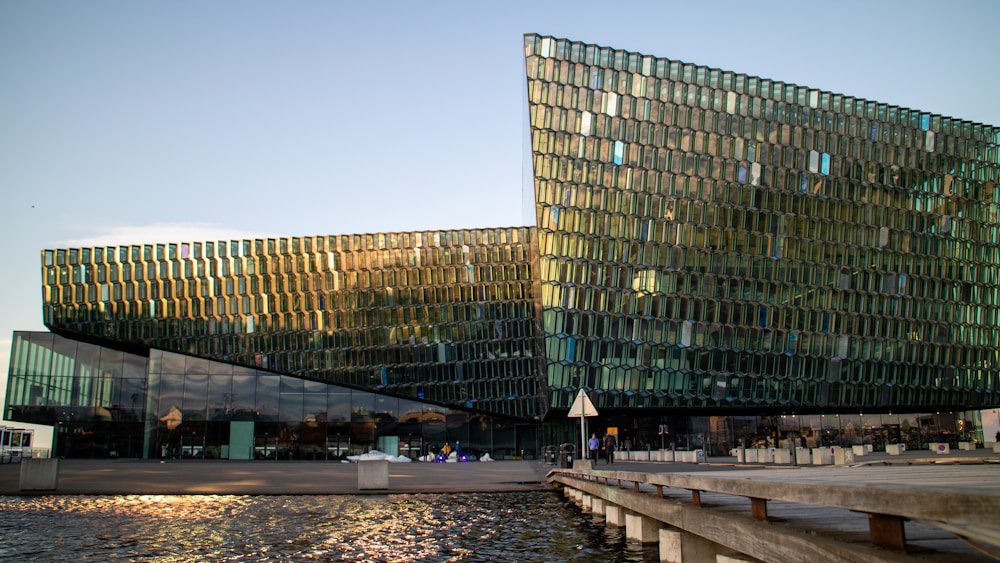
Harpa, Reykjavik’s iconic concert hall and conference centre, is a stunning architectural marvel located along the city’s waterfront. Designed by renowned artist Olafur Eliasson and Henning Larsen Architects, Harpa’s distinctive glass façade reflects the surrounding landscape, changing colours with the shifting light and creating a mesmerizing visual spectacle. Opened in 2011, Harpa has quickly become one of Reykjavik’s most recognizable landmarks, hosting a diverse range of events including concerts, conferences, exhibitions, and cultural performances. Its unique design and state-of-the-art facilities have earned it numerous accolades, including the prestigious Mies van der Rohe Award for European Architecture.
Visitors to Harpa can explore its striking interior, which features a variety of spaces including concert halls, theatres, meeting rooms, and exhibition areas. Guided tours are available for those interested in learning more about the building’s architecture and history, providing insights into its innovative design and the challenges faced during its construction. Additionally, Harpa’s schedule is filled with a wide array of events catering to all tastes, from classical music concerts to contemporary art exhibitions. Be sure to check the calendar in advance and book tickets for any performances or events that pique your interest.
Whales of Iceland
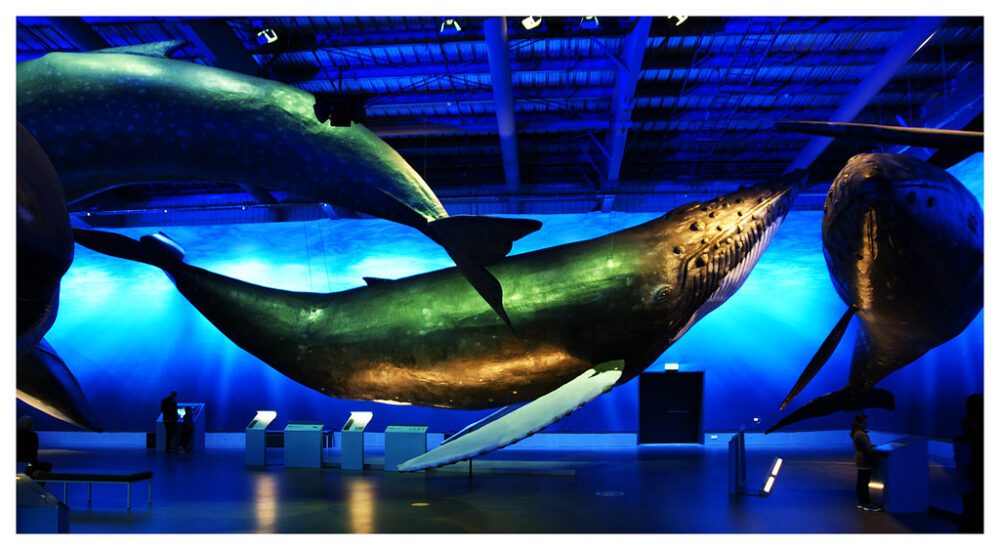
Whales of Iceland is an immersive museum located in Reykjavik that offers visitors a fascinating glimpse into the world of these magnificent marine mammals. The museum boasts an impressive collection of life-size whale models, including the massive blue whale, the majestic humpback whale, and the elusive orca. Each exhibit is meticulously crafted to provide an accurate representation of these creatures, allowing visitors to appreciate their sheer size and beauty up close. In addition to the lifelike models, Whales of Iceland features interactive displays, informative exhibits, and educational videos that delve into the biology, behaviour, and conservation efforts surrounding whales.
For those interested in learning more about Iceland’s rich maritime history and the importance of whale conservation, a visit to Whales of Iceland is both educational and entertaining. Visitors can explore the museum at their own pace, taking in the sights and sounds of the underwater world while gaining a deeper understanding of these fascinating creatures. Practical tips for visiting include checking the museum’s opening hours in advance, as they may vary depending on the season, and purchasing tickets online to skip the queue. Additionally, guided tours are available for those looking for a more in-depth experience, offering insights from knowledgeable guides and the opportunity to ask questions about whales and their habitats.
National Museum of Iceland

The National Museum of Iceland, located in Reykjavik, offers a comprehensive journey through the history and culture of Iceland from the earliest settlements to the present day. Founded in 1863, the museum’s extensive collection includes artefacts, artworks, and historical documents that provide insights into Iceland’s Viking heritage, the medieval period, and modern development. Exhibits cover a wide range of topics, including traditional Icelandic crafts, religious practices, political developments, and the country’s natural environment. One of the museum’s highlights is the permanent exhibition “Making of a Nation – Heritage and History in Iceland,” which showcases archaeological finds, medieval manuscripts, and interactive displays that bring Iceland’s past to life.
Practical tips for visiting the National Museum of Iceland include checking the museum’s opening hours and admission fees in advance, as they may vary depending on the season. Visitors should plan to spend at least a few hours exploring the museum’s extensive collections and taking advantage of guided tours or audio guides to enhance their experience. Additionally, the museum’s on-site cafe offers a cosy spot to relax and enjoy refreshments while reflecting on Iceland’s rich cultural heritage.
Perlan Museum
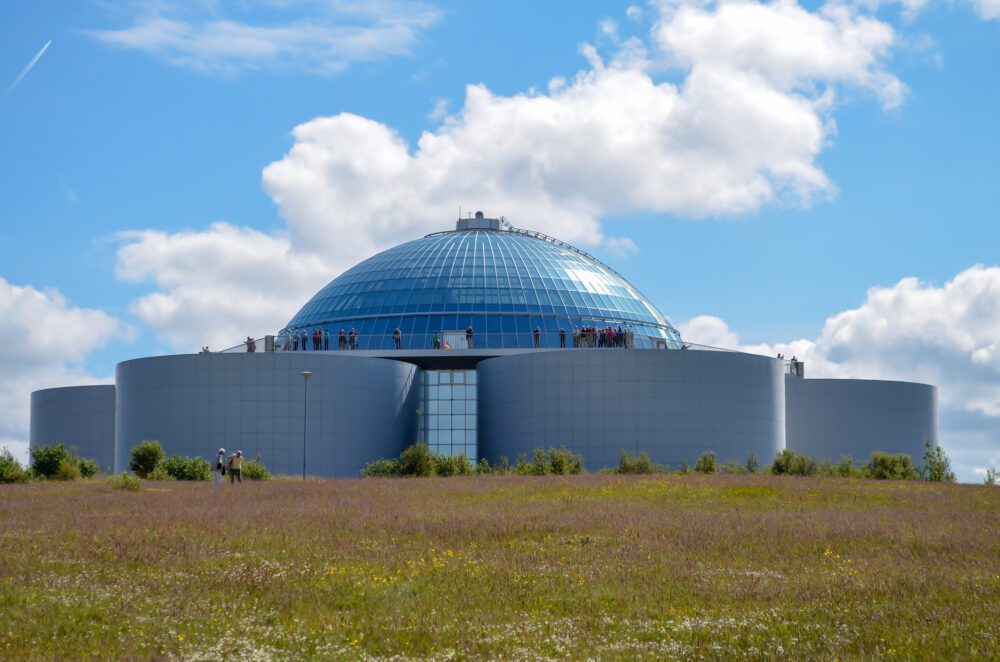
Perlan, or “The Pearl” in English, is one of Reykjavik’s most iconic landmarks and a must-visit destination for travellers seeking breathtaking views of the city and its surroundings. Perched atop Öskjuhlíð hill, this futuristic glass dome houses a rotating restaurant, exhibition space, and observation decks offering panoramic vistas of Reykjavik, the surrounding mountains, and the vast Atlantic Ocean. The history of Perlan dates back to the 1980s when six water storage tanks were covered with a glass dome to create a unique architectural structure. Over the years, Perlan has evolved into a multifunctional complex that combines entertainment, dining, and educational experiences for visitors of all ages.
Practical tips for visiting Perlan include checking the weather forecast before heading up the hill, as visibility can vary depending on the atmospheric conditions. Visitors can access Perlan by car, taxi, or public transportation, with ample parking available for those driving. Once inside, guests can purchase tickets to explore the exhibitions, enjoy a meal at the revolving restaurant, or simply take in the stunning views from the observation decks. Sunset and nighttime visits are particularly popular for capturing unforgettable photos of Reykjavik illuminated against the backdrop of the Northern Lights or the midnight sun.
Nautholsvik Geothermal Beach

Nauthólsvík Geothermal Beach is a unique attraction in Reykjavik where visitors can experience the contrast between the city’s urban environment and the soothing warmth of geothermal waters. Located just a short drive from the city centre, this man-made beach offers a relaxing oasis for locals and tourists alike. The history of Nauthólsvík dates back to the late 1990s when the area was developed to provide residents with a recreational space where they could enjoy swimming and sunbathing year-round. Today, the highlight of the beach is its geothermally heated seawater pool, which maintains a comfortable temperature even during Iceland’s chilly winters.
Practical tips for visiting Nauthólsvík include bringing a towel and swimsuit if you plan to take a dip in the pool or relax on the sandy shore. The beach facilities include changing rooms, showers, and a hot tub, making it easy to freshen up after your swim. Visitors can also rent beach chairs and umbrellas for added comfort while soaking up the sun. Additionally, Nauthólsvík is a popular spot for outdoor activities such as beach volleyball and paddleboarding, offering something for everyone to enjoy.
Laugavegur Street
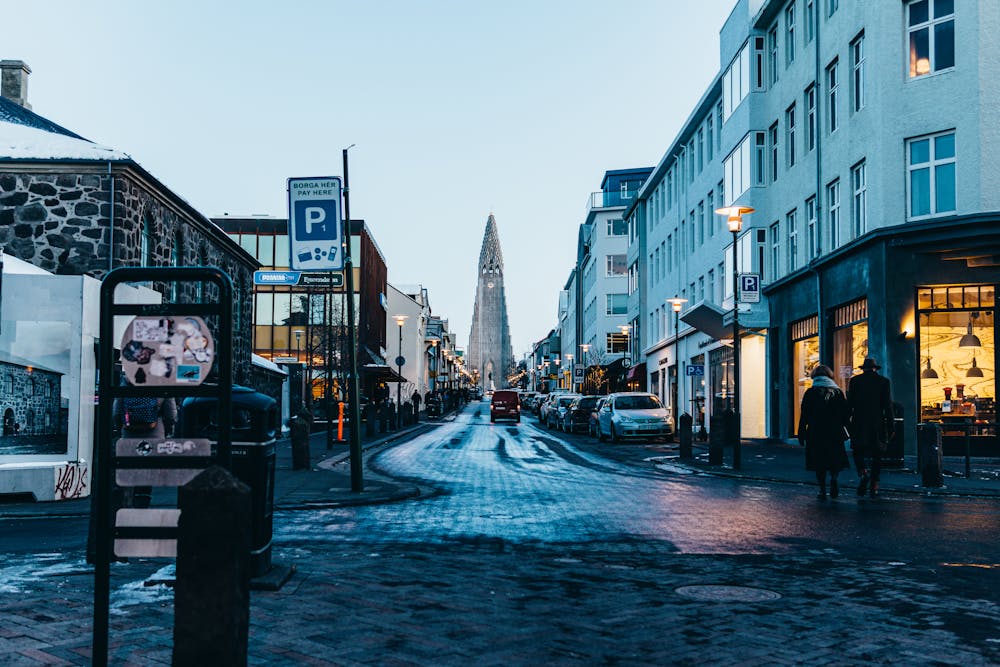
Laugavegur Street is the vibrant heart of Reykjavik’s shopping and dining scene, offering a blend of history, culture, and modern attractions. Originally a residential area in the 19th century, Laugavegur has evolved into the city’s main shopping thoroughfare, lined with boutiques, souvenir shops, cafes, and restaurants. The street’s name translates to “wash road,” a nod to its historical significance as a route used by locals to access the city’s thermal pools for washing clothes. Today, it is bustling with activity day and night, attracting locals and tourists alike who come to explore its eclectic mix of stores and eateries.
Practical tips for exploring Laugavegur Street include wearing comfortable walking shoes as you navigate the bustling sidewalks and pedestrian-friendly zones. The street is best explored on foot, allowing visitors to take in the colourful storefronts, street art, and architectural landmarks along the way. Be sure to stop by some of the local boutiques to browse for unique Icelandic souvenirs, such as woollen sweaters, handmade ceramics, and artisanal crafts. When hunger strikes, there are plenty of cafes and restaurants offering everything from traditional Icelandic cuisine to international fare.
Arbaer Open Air Museum
The Árbær Open Air Museum provides visitors with a fascinating glimpse into Reykjavik’s past, offering a unique opportunity to step back in time and experience traditional Icelandic life. Situated on the outskirts of the city, the museum features a collection of historic buildings that have been carefully preserved and restored to their original state. These structures include traditional homes, farmsteads, and workshops, showcasing various aspects of daily life in Iceland from the 19th century to the mid-20th century. Visitors can explore the interiors of these buildings, furnished with period-appropriate décor and artefacts, and learn about the customs, traditions, and occupations of Iceland’s rural inhabitants.
Practical tips for visiting the Árbær Open Air Museum include wearing comfortable shoes for walking around the expansive grounds, as there are many outdoor exhibits to explore. The museum is open year-round, with seasonal variations in opening hours, so it’s a good idea to check the schedule in advance. Guided tours are available for those who want a more in-depth understanding of the museum’s history and exhibits, but self-guided exploration is also a popular option. Additionally, the museum hosts special events and demonstrations throughout the year, offering visitors the chance to experience Icelandic culture through hands-on activities, traditional crafts, and live performances.
Sky Lagoon
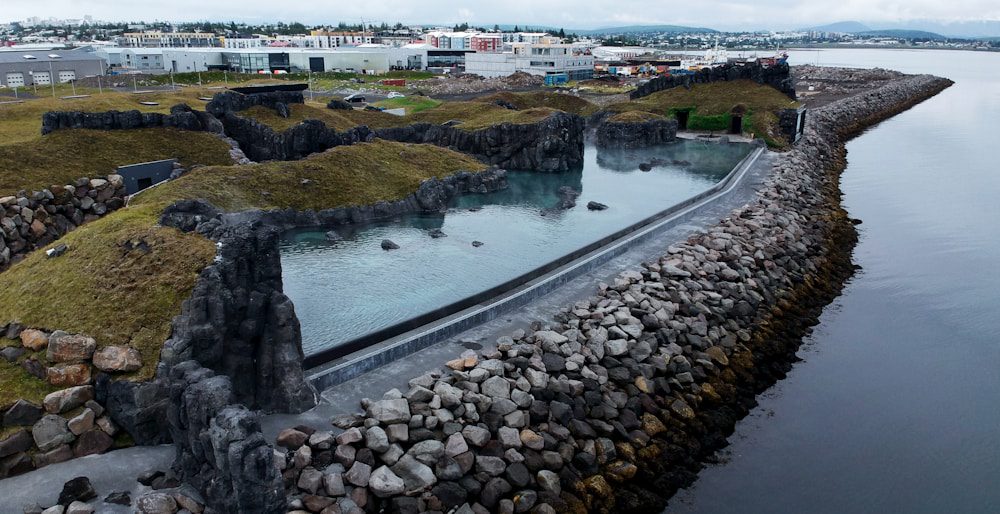
Sky Lagoon is a stunning geothermal spa located on the waterfront of Reykjavik, offering visitors a luxurious and rejuvenating experience with breathtaking views of the surrounding landscape. Inspired by Iceland’s natural beauty and rich geothermal heritage, Sky Lagoon combines modern amenities with traditional Icelandic spa rituals to create a one-of-a-kind wellness destination. The lagoon’s design is influenced by Iceland’s volcanic terrain, featuring mineral-rich waters heated by underground geothermal activity, providing a soothing and therapeutic bathing experience.
Practical tips for visiting Sky Lagoon include booking tickets in advance, especially during peak tourist seasons, to ensure availability and avoid long queues. Visitors can choose from a variety of experiences, including general admission to the lagoon, premium packages that include access to exclusive amenities such as private changing rooms and dining options, as well as spa treatments like massages and facials. It’s recommended to arrive early to make the most of your time at the lagoon and take advantage of the serene atmosphere before it gets crowded. Additionally, don’t forget to bring swimwear, a towel, and any other essentials you may need for your visit.
Golden Circle Tour
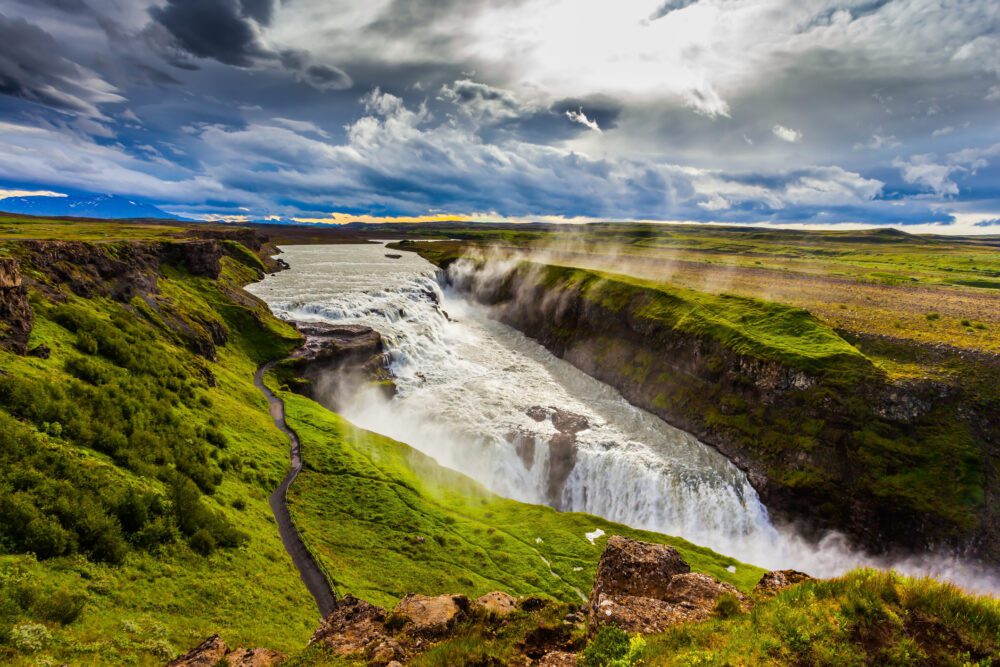
The Golden Circle is one of Iceland’s most iconic and popular tourist routes, encompassing three must-see attractions: Thingvellir National Park, Geysir Geothermal Area, and Gullfoss Waterfall. Each stop on the Golden Circle offers a unique glimpse into Iceland’s natural beauty and geological wonders. Thingvellir National Park holds historical significance as the site of Iceland’s first parliament, the Althing, established in 930 AD. It is also where the Eurasian and North American tectonic plates meet, creating a dramatic rift valley known as Almannagjá. Visitors can explore walking trails, witness the Althing’s ancient meeting site, and even snorkel or dive between the continental plates in the crystal-clear waters of Silfra Fissure.
Practical tips for exploring the Golden Circle include renting a car or joining a guided tour to visit all three attractions conveniently. While the Golden Circle can be completed in a single day, it’s worth allocating enough time to fully experience each stop without feeling rushed. For those driving themselves, be sure to check road conditions and weather forecasts, especially during the winter months when snow and ice may affect travel. Additionally, bring warm clothing, sturdy footwear, and plenty of snacks and water, as facilities can be limited at some stops.
Northern Lights
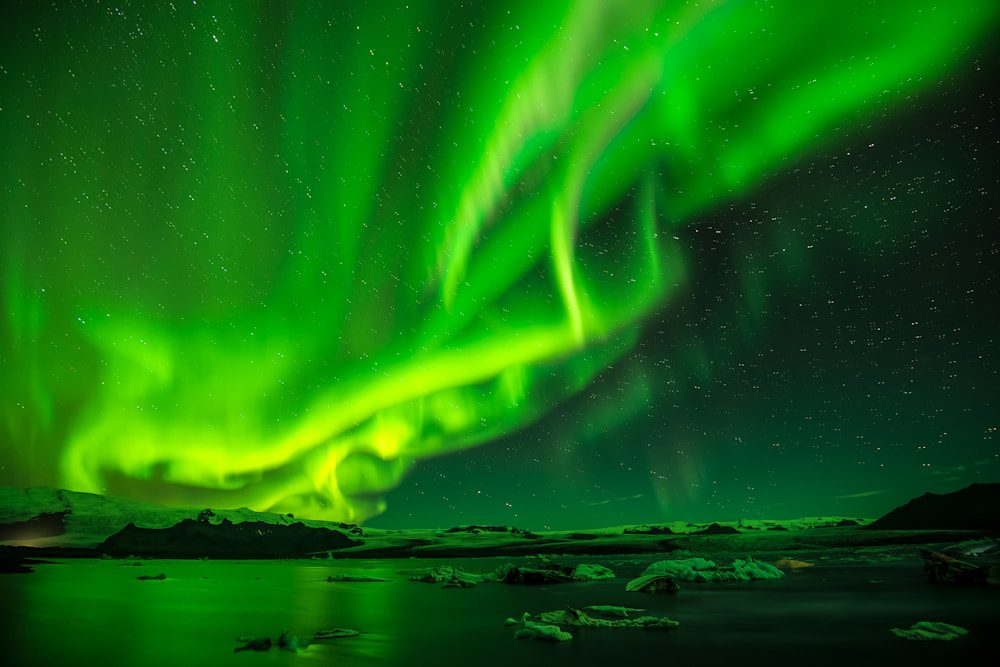
The Northern Lights, or Aurora Borealis, are one of nature’s most mesmerizing phenomena, captivating spectators with their dancing colours in the night sky. In Iceland, witnessing the Northern Lights is a bucket-list experience for many visitors. The lights are caused by solar particles colliding with gases in the Earth’s atmosphere, creating a stunning display of colours, including shades of green, pink, purple, and blue. Iceland’s location near the Arctic Circle makes it an ideal destination for viewing the Northern Lights, especially during the winter months when nights are long and dark. The best time to see the Northern Lights in Iceland is from late September to mid-April, with peak viewing times occurring in the darkest months of December and January.
Practical tips for viewing the Northern Lights include choosing dark, clear nights away from city lights to maximize visibility. Popular viewing spots in Iceland include Thingvellir National Park, the countryside surrounding Reykjavik, and the Snaefellsnes Peninsula. It’s also essential to monitor weather forecasts and aurora activity predictions to increase your chances of witnessing this natural spectacle. Consider booking a guided Northern Lights tour led by experienced local guides who can take you to the best viewing locations and provide insights into the science and folklore surrounding the Aurora Borealis. Remember to dress warmly, as temperatures can drop significantly during nighttime viewing sessions, and be patient, as sightings are not guaranteed and may require waiting for the right conditions.
Blue Lagoon

The Blue Lagoon is undoubtedly one of Iceland’s most iconic attractions, drawing visitors from around the world to its soothing geothermal waters. Located in the heart of a lava field on the Reykjanes Peninsula, the Blue Lagoon is a man-made geothermal spa fed by the waters of a nearby geothermal power plant. The water’s striking blue hue is due to its high silica content, which reflects sunlight in a captivating display. The Blue Lagoon’s history dates back to the 1970s when locals discovered the water’s healing properties and began bathing in it. Today, the Blue Lagoon has evolved into a world-renowned spa destination, offering visitors the opportunity to relax and rejuvenate in its mineral-rich waters while surrounded by Iceland’s stunning volcanic landscape.
Practical tips for visiting the Blue Lagoon include booking tickets in advance, as it’s one of Iceland’s most popular attractions and can sell out quickly, especially during peak seasons. Consider opting for premium packages that include additional amenities such as bathrobes, slippers, and exclusive access to secluded areas of the lagoon. To enhance your experience, indulge in spa treatments like massages, facials, and algae masks, all of which utilize the lagoon’s mineral-rich waters and natural ingredients. After soaking in the lagoon’s warm waters, be sure to explore other facilities such as saunas, steam rooms, and relaxation areas. Additionally, take advantage of on-site dining options serving Icelandic cuisine and refreshing beverages, allowing you to savour the ultimate relaxation experience.
Whale Watching
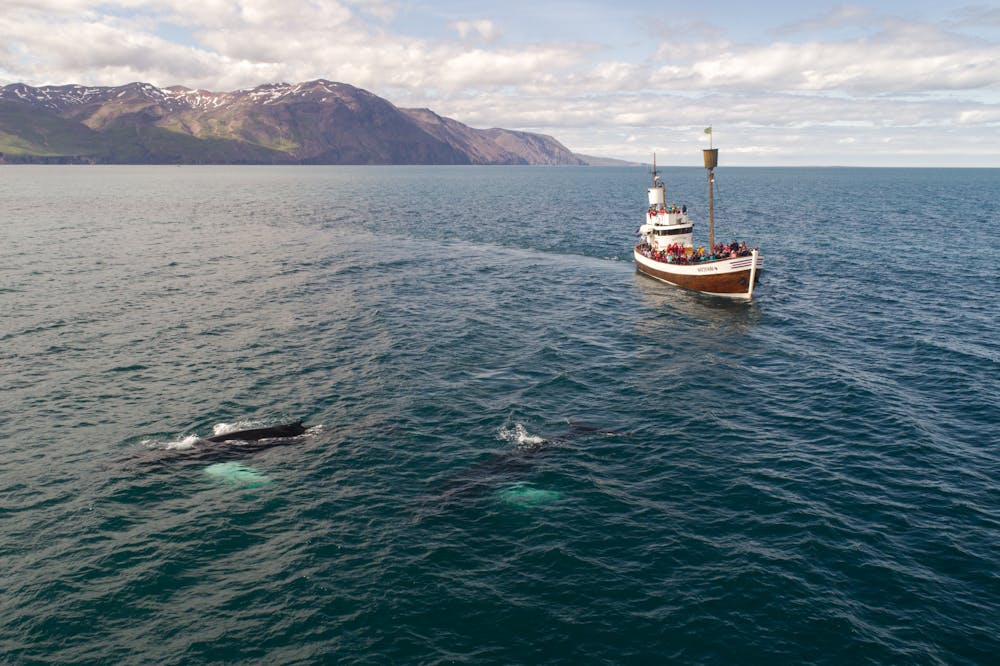
Whale-watching tours in Reykjavik offer an incredible opportunity to witness these majestic marine mammals in their natural habitat. With a rich history rooted in Iceland’s maritime culture, whale watching has become a popular activity for visitors seeking unforgettable wildlife encounters. The nutrient-rich waters surrounding Iceland attract a variety of whale species, including humpback whales, minke whales, orcas, and even the elusive blue whale, the largest animal on Earth. These tours typically depart from Reykjavik’s old harbour, where knowledgeable guides provide fascinating insights into the behaviour and biology of the whales you may encounter. Many operators offer comfortable and spacious vessels equipped with amenities such as heated indoor cabins and outdoor viewing decks, ensuring a comfortable and enjoyable experience for passengers of all ages.
When planning a whale-watching tour in Reykjavik, it’s essential to dress warmly and wear layers, as the weather at sea can be unpredictable and chilly, even during the summer months. Additionally, consider bringing binoculars and a camera to capture the breathtaking moments when whales breach or surface near the boat. Be sure to choose a reputable tour operator with experienced guides who prioritize the safety and well-being of both passengers and marine life. While sightings of whales are never guaranteed due to the animals’ unpredictable behaviour, the thrill of spotting these magnificent creatures in their natural habitat is an experience you’ll cherish for a lifetime.
Day Trips from Reykjavik
Snaefellsnes Peninsula
A day trip to the Snaefellsnes Peninsula from Reykjavik offers a captivating journey through Iceland’s diverse landscapes and geological wonders. Known as “Iceland in Miniature,” the peninsula boasts an array of natural attractions, including towering mountains, dramatic coastlines, lava fields, and the iconic Snaefellsjokull volcano. Believed by some to be one of Earth’s mystical energy centres, Snaefellsjokull gained literary fame as the entrance to the centre of the Earth in Jules Verne’s novel “Journey to the Center of the Earth.” Visitors can explore the rugged beauty of the peninsula by embarking on scenic drives along the coastal roads, stopping at picturesque fishing villages like Arnarstapi and Hellnar, where they can stroll along scenic coastal cliffs and admire stunning sea arches and rock formations carved by the powerful North Atlantic waves.
Practical tips for a day trip to the Snaefellsnes Peninsula include starting early to make the most of your time exploring this breathtaking region. Be sure to pack essentials such as sturdy hiking boots, waterproof clothing, snacks, and plenty of water, as weather conditions can change rapidly, and facilities may be limited in some areas. Don’t miss the opportunity to visit attractions like Djupalonssandur beach, known for its black volcanic sands and the haunting remnants of a shipwreck, or the charming town of Stykkisholmur, where you can enjoy fresh seafood and panoramic views of the surrounding fjords.
South of Iceland
A day trip to the south of Iceland from Reykjavik unveils a tapestry of natural wonders and cultural treasures, showcasing the country’s rich history and breathtaking landscapes. One of the most iconic stops along this route is the majestic Seljalandsfoss waterfall, where visitors can walk behind the cascading waters for a unique perspective and capture stunning photographs of the surrounding scenery. Nearby, the equally impressive Skogafoss waterfall plunges dramatically from a height of 60 meters, offering another awe-inspiring sight to behold. History enthusiasts will appreciate a visit to the Skogar Museum, which provides insight into Iceland’s rural past with its collection of historical artefacts and traditional turf houses.
Practical tips for a day trip to the south of Iceland include renting a car or joining a guided tour to make the most of your time exploring the region. Be prepared for changing weather conditions by dressing in layers and bringing waterproof clothing, as rain and wind are common in this area. Additionally, fuel up with a hearty breakfast before setting out on your journey, as dining options may be limited in remote areas. Don’t miss the opportunity to visit the black sand beaches of Reynisfjara, known for their dramatic basalt columns and stunning coastal vistas. Finally, round out your day with a visit to the charming village of Vik, where you can savour local cuisine, shop for souvenirs, and soak in the tranquil atmosphere before returning to Reykjavik.
Conclusion
Reykjavik offers a wealth of experiences that cater to diverse interests, making it an ideal destination for travellers seeking adventure, culture, and natural beauty. From iconic landmarks like the Hallgrimskirkja and Harpa to unique attractions such as the Whales of Iceland Museum and Nautholsvik Geothermal Beach, Reykjavik captures the imagination and leaves a lasting impression on visitors. Whether exploring the city’s vibrant streets, embarking on excursions to nearby natural wonders, or indulging in the warmth of Iceland’s geothermal pools, Reykjavik beckons travellers to discover its many charms and surprises.
With its blend of history, culture, and natural wonders, Reykjavik invites visitors to delve into its captivating offerings and create memories that will last a lifetime. Whether strolling along Laugavegur Street, marvelling at the Northern Lights, or embarking on a whale-watching adventure, Reykjavik promises an unforgettable journey filled with discovery and wonder. As travellers bid farewell to this enchanting city, they carry with them not only cherished experiences but also a deep appreciation for Reykjavik’s unique spirit and allure.
